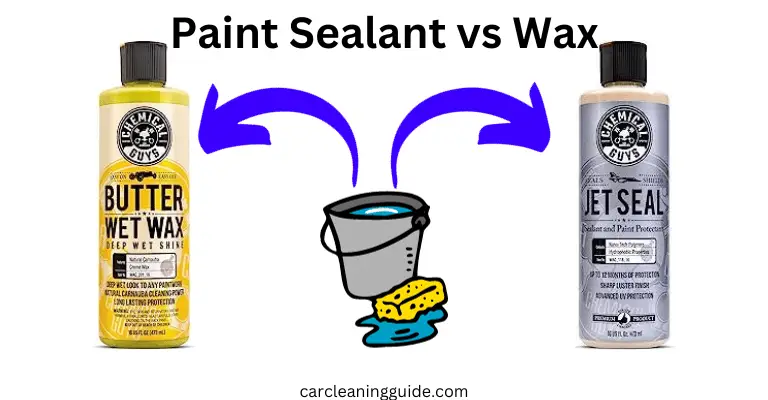- How to Clean Car Carpets Quickly (Without An Extractor) - July 10, 2024
- Can You Touch Up Clear Coat On A Car? Yes and No (Here’s Why) - November 25, 2023
- How To Wax A Car By Hand (For Beginners) - November 14, 2023
Last Updated on December 10, 2024 by Nate Schnell
When it comes to car detailing, few debates are as enduring as the one between paint sealants and waxes. Both products are designed to protect your car’s paint and enhance its shine, but they go about it in slightly different ways. The good news? There’s no wrong choice—just the one that best fits your needs. Let’s dive into what makes these two products unique, when to use them, and how to decide which one deserves a spot in your car care routine.
Understanding the Basics: Sealant and Wax
The first thing to know is that paint sealants and waxes share the same primary goal: protecting your car’s paint. They both act as a barrier against harmful elements like UV rays, dirt, and water while giving your car a polished look. The difference lies in how they achieve these results.
Wax, often made from natural ingredients like carnauba, gives your car a deep, warm shine. It’s like the little black dress of car care—classic, timeless, and always a crowd-pleaser. On the other hand, paint sealants are synthetic products designed for longevity and durability. They bond to your car’s paint at a molecular level, creating a tough, glossy finish that can stand up to harsher conditions.
Why Choose Wax?
Wax has been a staple in car care for decades, and it’s easy to see why. It offers a look that many car enthusiasts find irresistible: a rich, natural glow that enhances your car’s color and depth. If you own a classic car or love the nostalgia of a showroom finish, wax is a fantastic choice. It’s also a quick fix when you need a fast shine—perfect for car shows or last-minute touch-ups. Wax works especially well if your car isn’t exposed to extreme weather or if you’re okay with reapplying it every couple of months to keep that fresh-off-the-lot look.
Why Choose Paint Sealant?
If you’re looking for long-term protection with less maintenance, paint sealant is the way to go. Sealants are engineered for durability, often lasting up to six months or more, depending on the product and conditions. They’re ideal for new cars or vehicles exposed to harsh environments, like intense sunlight, heavy rain, or salty roads. While the finish might lack the warm, soft glow of wax, it compensates with a sleek, high-gloss shine that looks almost mirror-like. If you want reliable protection that requires less frequent reapplication, sealant might be your best bet.
What’s the Difference?
Let’s talk details. The primary difference between wax and sealant comes down to their composition and performance. Wax, especially carnauba-based products, is derived from natural ingredients, which gives it that signature warm finish. Sealants, being synthetic, are all about strength and longevity. Wax tends to wear off faster, especially in hot weather or after repeated washes, while sealants hold up better over time.
Another key difference is how they make your car look. Wax emphasizes depth and richness, giving the paint a vibrant glow. Sealants, on the other hand, create a glossy, reflective finish that’s more modern and polished. The decision often comes down to whether you prefer the classic appeal of wax or the high-tech resilience of a sealant.
When to Use Wax
There are certain situations where wax really shines—literally. Classic cars are a prime example. Their curves and details look amazing under a layer of wax, which enhances their vintage appeal. Wax is also great when you need a quick fix. If you’ve got an event or car show coming up, a fresh coat of wax can transform your car’s appearance in no time. It’s also a good option if you enjoy the process of car care. There’s something satisfying about applying wax by hand and buffing it to perfection.
When to Use Sealant
For new cars or vehicles that face challenging conditions, sealant is hard to beat. Its durability makes it ideal for busy people who don’t want to reapply protection every couple of months. If you live in an area with harsh weather—think blazing sun, heavy snow, or salty roads—a sealant will help preserve your car’s paint for longer. It’s also a smart choice if you prioritize low maintenance or simply want peace of mind knowing your car is well-protected.
Are There Any Downsides?
Both products have their drawbacks, and it’s worth considering these before you make a decision. Wax, for all its beauty, doesn’t last as long as sealant and may need to be reapplied every two to three months. It can also be sensitive to high temperatures, meaning it might melt or degrade faster in hot climates. Sealants, while durable, can be harder to apply. They require a cleaner surface to bond effectively and may not provide the same warm, natural glow that wax offers. Plus, they can be a bit pricier upfront, though their longevity often makes up for it.
Choosing the Right Product for You
Ultimately, the decision between wax and sealant comes down to your priorities. Are you someone who loves the ritual of waxing your car on a sunny weekend? Do you crave that classic, deep shine that makes heads turn? If so, wax might be your perfect match. On the other hand, if you want long-lasting protection with less upkeep, or if your car faces tough conditions, sealant could be the better choice.
For some car owners, the answer is both. It’s not uncommon to layer products, starting with a paint sealant for durability and finishing with a wax for that extra shine. This combination gives you the best of both worlds: robust protection and eye-catching aesthetics.
Final Thoughts
In the end, whether you choose wax, sealant, or a combination of the two, your car will benefit from the added care and protection. Wax brings a timeless elegance, while sealant delivers modern durability. By understanding what each product offers, you can make an informed choice that suits your car’s needs and your lifestyle. No matter which you pick, your vehicle will thank you for the attention, and you’ll enjoy the satisfaction of driving a car that looks as good as it feels.



